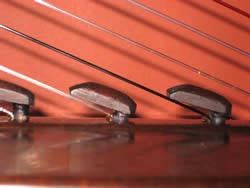Other flat bridged instruments 4
The stick-zither ddong can be found in Vietnam. Very primitive in form; it is not unlike the stick-zithers of old India and those found today in Central Africa.
The flat bridge has also been applied to various western guitar designs, some even with resonating strings attached across the soundboard or even on an extra neck. It shows that in these times, experiments are made to try and satisfy the needs of the musicians to expand on their ideas concerning sound quality. A promising development producing new and exciting musical possibilities.
The buzz effect that is one of the sounds produced when the string grazes the flat bridge can be produced on an instrument by various other means. This does give a similar effect of the Indian bridge, but is not made with the precision needed to produce the realm of overtones used in Indian instruments.
Variations on this theme can be found In Europe. For example, we can hear the buzz in The Brey Harp. It was the familiar sound of the gut-strung harp across Europe for several hundred years, played between the 14th and 18th centuries, and heard in Wales into the early 19th century. They were the classic harps during the Renaissance. The buzzing is produced by tiny L-shaped wooden pegs, called bray pins. These bray pins hold the strings in the sound box and also lightly touch them. This light point of contact causes the buzzing sound as the string vibrates.

The “buzz” on many African musical instruments is more often than not the preferred sound. This can be achieved by various means, from the flat table bridge as we have seen on the Ethiopian Beganna, or by cigarette papers fitted to the kalabas of some xylophones such as the balafon. Bridgeless lutes or lyres can sometimes aquire the buzz by simply allowing the sting to vibrate on the sound board or skin.
